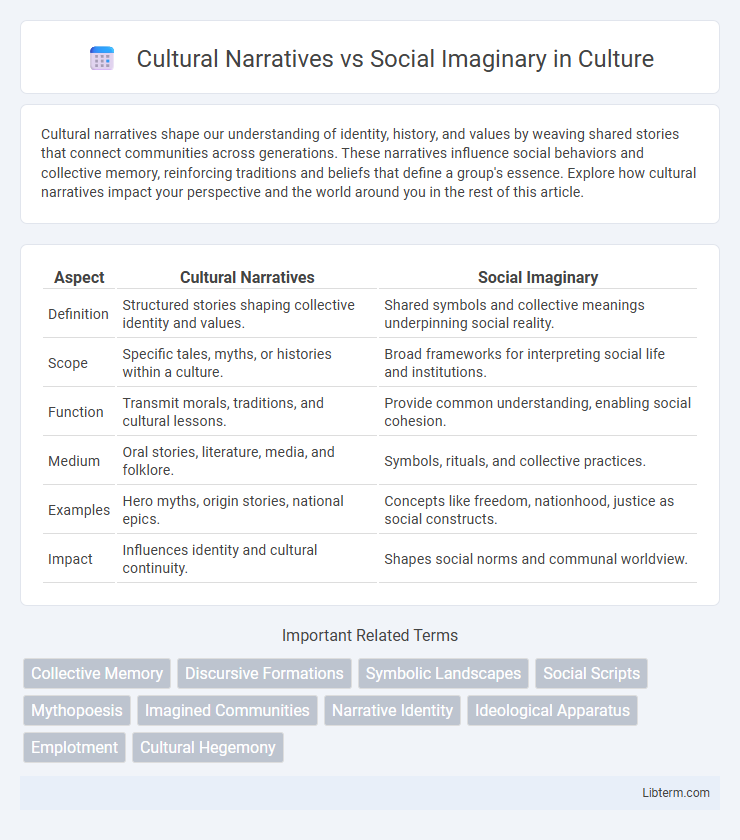Cultural narratives shape our understanding of identity, history, and values by weaving shared stories that connect communities across generations. These narratives influence social behaviors and collective memory, reinforcing traditions and beliefs that define a group's essence. Explore how cultural narratives impact your perspective and the world around you in the rest of this article.
Table of Comparison
| Aspect | Cultural Narratives | Social Imaginary |
|---|---|---|
| Definition | Structured stories shaping collective identity and values. | Shared symbols and collective meanings underpinning social reality. |
| Scope | Specific tales, myths, or histories within a culture. | Broad frameworks for interpreting social life and institutions. |
| Function | Transmit morals, traditions, and cultural lessons. | Provide common understanding, enabling social cohesion. |
| Medium | Oral stories, literature, media, and folklore. | Symbols, rituals, and collective practices. |
| Examples | Hero myths, origin stories, national epics. | Concepts like freedom, nationhood, justice as social constructs. |
| Impact | Influences identity and cultural continuity. | Shapes social norms and communal worldview. |
Defining Cultural Narratives: Foundations and Functions
Cultural narratives constitute the shared stories and symbols that shape a community's identity, history, and values, providing a framework for interpreting experiences and guiding behavior. They function as foundational structures that transmit collective memory, reinforce social norms, and enable cohesion through common language and meaning. These narratives are embedded in traditions, myths, and rituals, serving as key tools for maintaining continuity across generations while adapting to social change.
What is Social Imaginary? Concepts and Evolution
Social imaginary refers to the collective set of values, institutions, laws, and symbols through which people imagine their social whole, creating a shared sense of reality and belonging. Originating from the work of sociologists like Cornelius Castoriadis and Charles Taylor, the concept has evolved to encompass how societies construct and communicate meaning beyond explicit knowledge or narratives. This evolving framework shapes cultural norms and social practices, influencing political legitimacy and communal identity across historical and contemporary contexts.
Key Differences Between Cultural Narratives and Social Imaginary
Cultural narratives consist of shared stories and symbols that convey the values, beliefs, and historical experiences of a community, often passed down through generations. Social imaginary refers to the collective set of values, institutions, laws, and symbols through which people imagine their social existence and establish common cultural frameworks. While cultural narratives emphasize specific storytelling elements, social imaginary encompasses broader societal structures shaping how individuals collectively perceive reality.
Intersections: Where Cultural Narratives and Social Imaginary Meet
Cultural narratives and social imaginary intersect where shared stories shape collective identities and social realities, influencing perceptions and behaviors within communities. These intersections reveal how myths, traditions, and symbols embed within societal frameworks, guiding norms and values. Understanding this synergy is crucial for analyzing how cultural meaning is constructed and sustained across social groups.
Historical Contexts Shaping Social Imaginaries
Historical events and collective memory shape social imaginaries by embedding shared meanings and symbols that influence societal values, identities, and institutions. Cultural narratives, which consist of stories, myths, and traditions passed through generations, provide the frameworks through which social imaginaries are understood and sustained. The ongoing interaction between historical contexts and cultural narratives continuously reconstructs social imaginaries, reflecting evolving power dynamics and collective experiences.
The Role of Storytelling in Crafting Cultural Narratives
Storytelling plays a crucial role in crafting cultural narratives by preserving shared values, beliefs, and histories that shape a community's identity over time. Cultural narratives are constructed through repeated stories that reinforce collective memory and social norms, providing meaning and cohesion within societies. These narratives influence the social imaginary by embedding symbolic frameworks that guide the way individuals imagine their social world and possibilities for change.
How Social Imaginary Influences Collective Identity
Social imaginary shapes collective identity by embedding shared symbols, practices, and meanings within a community's daily life, guiding how people perceive their social reality and their roles within it. This collective framework influences cultural narratives by providing the underlying assumptions and values that inform storytelling, traditions, and social norms. As a result, social imaginary acts as a foundational force in unifying individuals into a coherent group identity through common understanding and shared experience.
Media’s Impact on Narratives and Imaginaries
Media shapes cultural narratives by disseminating dominant stories that influence collective memories, values, and identities within societies. Through repeated representation in films, news, and social platforms, media constructs and reinforces social imaginaries, which are shared frameworks of meaning shaping how communities envision their social realities. This dynamic interplay determines public perception and social cohesion by embedding particular ideologies and cultural assumptions in everyday discourse.
Changing Narratives: Power, Resistance, and Transformation
Cultural narratives shape collective identities by transmitting shared values and historical experiences, while social imaginaries represent the broader frameworks through which societies envision their existence and future possibilities. Changing narratives involve the contestation of power, where marginalized groups resist dominant stories to redefine social norms and challenge institutional structures. This dynamic process fosters transformation by enabling new meanings and frameworks that reflect diverse perspectives and promote social justice.
Cultural Narratives vs Social Imaginary: Implications for the Future
Cultural narratives shape collective identity by embedding shared values and historical memory, while the social imaginary encompasses the broader symbolic framework that influences societal expectations and norms. Understanding the interplay between cultural narratives and the social imaginary is crucial for addressing future challenges in social cohesion, as evolving narratives can redefine group identities and societal aspirations. The dynamic interaction between these concepts guides policy-making and cultural development, impacting how communities adapt to globalization, technological change, and social justice movements.
Cultural Narratives Infographic

 libterm.com
libterm.com